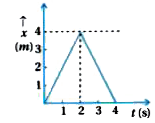The displacement vector of a particle of mass m is given by r(t) = ˆiAcosωt+ˆjB sin ωt.
(a) Show that the trajectory is an ellipse.
(b) Show that F=mω2r Solution in Gujrati
Displacement vector →r=xˆj+yˆj
here →r=(acostˆj)=(BsinˆI)
Which is equation of ellipse
(b ) velocity of the particle
v=drdt=ˆIddt+ˆjddt
Acceleration of the particle (a )
or a= Add(sinˆj+Bddtcosˆj)
=[ˆjcost+ˆjBsint]
force acting on the particle
f=ma=−mw2r Hence prove.
Topper's Solved these Questions
- LAW OF MOTIONBOOK - KUMAR PRAKASHANCHAPTER - LAW OF MOTIONEXERCISE - SECTION -E(MULTIPLE CHOICE QUESTIONS) (MCQS)
69 Videos
- LAW OF MOTIONBOOK - KUMAR PRAKASHANCHAPTER - LAW OF MOTIONEXERCISE - SECTION-F (QUESTIONS FROM MODULE)
22 Videos
- LAW OF MOTIONBOOK - KUMAR PRAKASHANCHAPTER - LAW OF MOTIONEXERCISE - SECTION-C(OBJECTIVE QUESTIONS) (VSQS)
55 Videos
- GRAVITATIONBOOK - KUMAR PRAKASHANCHAPTER - GRAVITATIONEXERCISE - QUESTIONS PAPER Section - D
1 Video
- MACHANICAL PROPERTIES OF SOLIDS BOOK - KUMAR PRAKASHANCHAPTER - MACHANICAL PROPERTIES OF SOLIDS EXERCISE - QUESTION PAPER
11 Videos
Similar Questions
The position (x) → time (t) graph of one dimensional motion of a body of mass 0.4 kg. What is the magnitude of impulse of force

View SolutionA block rests on a rough inclined plane making an angle of 30° with the horizontal. The coefficient of static friction between the block and the plane is 0.8. If the frictional force on the block is 10 N, the mass of the block ((in kg) is .......... (Take g = 10 m/s2)
View SolutionArea of F → t graph gives which physical quantity ?
View SolutionA spaceship is stationed on Mars. How much energy must be expended on the spaceship to launch it out of the solar system ? Mass of the spaceship = 1000 kg, mass of the sun =2×1030kg, mass of mars =6.4×1023kg, radius of mars = 3395 km, radius of the orbit of mars =2.28×108km,G=6.67×10−11Nm2kg2
View SolutionWhat is called brittle material ?
View SolutionThe displacement vector of a particle of mass m is given by r (t) = ˆiAcosωt+ˆjBsinωt.
(a) Show that the trajectory is an ellipse.
(b) Show that F = −mω2r.
View SolutionIf a particle is moving on an parallel path given by r=b cos omegat hati+asinomegat hatj , then find its radial acceleration along r
View SolutionIf s=a sinωtˆi+bcosωtˆj, the equation of path of particle is
View SolutionThe displacement vector of a particle of mass m is given by r (t) = hati A cos omega t + hatj B sin omega t . (a) Show that the trajectory is an ellipse. (b) Show that F = -m omega^(2)r .
View Solutionयदि वेक्टर →A=cosωtˆi+sinωtˆj तथा वेक्टर →B=cosωt2ˆi+sinωt2ˆj समय के फलन है तब समय t का वह मान क्या होगा जिस पर ये वेक्टर परस्पर लंबकोणिक (orthogonal) होंगे :
View SolutionThe displacement s of a particle at time t is given by s=αsinωt+βcosωt then acceleration at time t is
View Solutionदोलन करते हुए एक कण का विस्थापन x=asinωt+bcosωt द्वारा प्राप्त होता है जहाँ a,b नियतांक है -
दर्शाइए की कण की गति सरल आवर्त गति है।
View SolutionThe position vector of a particle is→r=(acosωt)ˆi+(asinωt)ˆj. the velocity of the particle is
View SolutionThe displacement vector of a particle of mass m is given by r (t) = ˆiAcosωt+ˆjBsinωt.
(a) Show that the trajectory is an ellipse.
(b) Show that F = −mω2r.
View SolutionA particle moves in the x-y plane according to the equation, vecr=(hati+hatj)(A sin omegat+B cos omegat) . Motion of the particle is :
View Solution